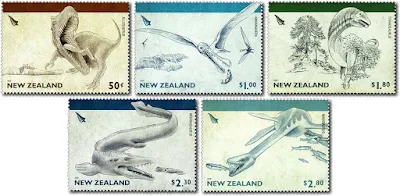In 2010 New Zealand Post celebrated our incredible extinct natural heritage with an issue of five oversized stamps and five amazing coins. These species disappeared 65 million years ago, but with a little help from New Zealand Post, you can see what it might have been like to meet them face to face. A hundred million years ago, our land formed the eastern margin of the southern super-continent of Gondwanaland. Separated by ocean, ‘Zealandia’ had its own group of dinosaurs, pterosaurs (flying reptiles) and giant marine reptiles that thrived here for 20 million years.
The Stamps.
The Ancient Reptiles of New Zealand stamp and coin issue explores the behaviour and habitats of this exceptional group of animals as if an explorer has travelled back in time and observed them directly. Illustrations on the stamps and coins are ‘field sketches’ – reconstructions based on the most up-to-date information on animal behaviour, ecology and New Zealand palaeontology.
50c - Allosaurus.
At 12 metres long, Allosaurus was the largest meat eater on land in the region. It was at the top of the food chain and, it has been suggested, had a cooperative social behaviour, hunting in packs, much like lions do today. It was able to open its jaws extremely widely, allowing it to attack large prey.
$1.00 - Anhanguera.
This pterosaur was the most common flying reptile in Zealandia. Fish eaters with a five-metre wingspan, they formed large coastal nesting colonies, similar to the seabirds of our time. They laid leathery eggs, and the flight centres in the brains of the young developed well before
hatching, suggesting that they could fly from birth.
hatching, suggesting that they could fly from birth.
$1.80 - Titanosaurus.
Titanosaurus was the last descendant of the giant sauropods. It was small for a member of this group of dinosaurs, just 14 metres long, but was still massive and weighed about 13 tonnes. It was tall enough to browse the treetops and large ferns, travelling as part of an extensive herd to protect itself from predators.
$2.30 - Moanasaurus.
The mosasaurs (including Moanasaurus) were the top predators of the shallow coasts of Zealandia. At 12 metres long, with a 78-centimetre long skull, Moanasaurus would have been a fearsome predator, undulating its snake-like body through the water a little like a crocodile with paddled feet. Although mosasaurs were widespread across the world, Moanasaurus was specific to this region.
$2.80 - Mauisaurus.
Mauisaurus was a 20-metre marine reptile (plesiosaur), the largest of its kind in the world. It was an ‘elasmosaur’, the type of plesiosaur with a tiny head and very long neck. This meant that, for all its size, its diet was restricted to small fish and squid in the shallow coastal waters in which it lived.
The First Day Cover.
The stamps were also issued in a self-adhesive format on the miniature sheet shown above and a Silver Bullion coin set.
Technical information.
Date of issue:
|
3 March 2010.
|
|---|---|
Number of stamps:
|
Five gummed stamps.
|
Denominations:
|
50c, $1.00, $1.80, $2.30, $2.80.
|
Stamps, miniature sheet and first-day cover designed by:
|
Eklektus Inc., Wellington, New Zealand.
|
Printer and process:
|
Southern Colour Print, Dunedin, New Zealand by offset lithography.
|
Number of colours:
|
Four process colours (plus red phosphor tagging on miniature sheet).
|
Stamp size and format:
|
52mm x 37.5mm (horizontal).
|
Paper type:
|
Tullis Russell 104gsm red phosphor gummed stamp paper.
|
Number of stamps per sheet:
|
20 stamps
|
Perforation gauge:
|
14.40 x 14.60.
|
Period of sale:
|
Unless stocks are exhausted earlier, these stamps will remain on sale until close of business 2 March 2011.
|
Some of the images in this post were used with permission from the illustrated catalogue of StampsNZ
You can visit their website and On-line Catalogue at, http://stampsnz.com/
Information for this post came from.








We appreciate your engagement with our content. To ensure a respectful and constructive community, please take note of the following:
- No Spam, Please: We do not tolerate spammy or promotional comments. Any such comments will be promptly removed.
- Moderation in Place: All comments are moderated to maintain a positive and inclusive environment. Please be patient, as it may take a little time for your comment to appear.
- Sign In with Google: To comment, please sign in using your Google account. This helps us maintain the integrity of our community and allows for better interaction.